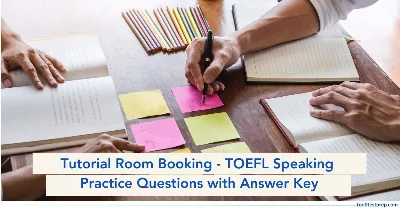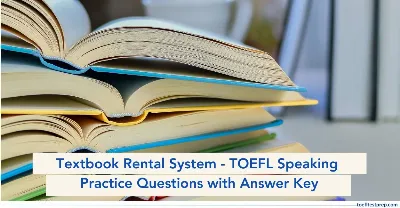Earthquakes - TOEFL Reading Practice Test

"Strengthen TOEFL reading skills with passages on earthquakes, exploring geological concepts, effects, and scientific vocabulary. Ideal for comprehension, inference, and structure practice."
Proficiency in reading academic texts is essential for success in the TOEFL Reading section, which reflects the demands of English-speaking academic settings. This section assesses your ability to locate main ideas, extract details, make inferences, and grasp text structure. Regular practice is key to improvement.
Our practice tests simulate the TOEFL’s format, preparing you thoroughly for the test. Try the "Earthquakes" TOEFL Practice Test to become accustomed to the exam format and identify where you can improve.
Reading Instructions:
- You have 15 minutes to read the following passage and answer all 9 questions related to it.
- Most questions are worth 1 point, but the last question is worth more. The directions indicate how many points you will receive for that specific question.
- The specific section/paragraphs have been provided again with the question for ease of understanding and quick solution.
- Some questions include a word or phrase that is highlighted in the question as well as in the paragraph for quick reference.
Earthquakes
Earthquakes are natural occurrences marked by the sudden release of energy in the Earth's crust, resulting in shock waves that can cause significant ground shaking. This release of energy is mainly due to the movement of earth plates, which are large sections of the Earth's outer layer that float on the semi-fluid layer beneath them. The boundaries where these plates meet are often sites of considerable earth activity, including earthquakes. The size and intensity of an earthquake can vary widely, influenced by factors such as the depth of the earthquake source, the geological makeup of the area, and the distance from populated regions. Understanding how earthquakes work is essential for assessing risks and putting into action effective safety measures, especially in areas likely to experience seismic activity.
The main cause of earthquakes is the movement of earth plates, which can happen through different mechanisms. At converging boundaries, where two plates collide, one plate may be pushed beneath the other in a process called sinking. This interaction can lead to the build-up of stress along fault lines, which, when released, results in an earthquake. On the other hand, at diverging boundaries, where plates move apart, molten rock can rise to fill the gap, causing volcanic activity and earthquakes. Sliding boundaries, where plates move past each other, can also produce significant seismic activity. The interaction of these earth processes shows the dynamic nature of the Earth's crust and the potential for earthquakes in various geographical areas, including regions like the Pacific Ring of Fire, which is particularly likely to experience seismic events.
Earthquakes are measured using earthquake detectors, instruments that detect and record the vibrations caused by shock waves. The Richter scale, developed in the 1930s, measures the size of an earthquake based on the amplitude of these waves. However, this scale has limitations, especially for large earthquakes, leading to the use of the moment magnitude scale (Mw), which provides a more accurate representation of an earthquake's size by considering the area of the fault that slipped and the amount of slip. Additionally, the Modified Mercalli Intensity scale assesses the effects of an earthquake on people, buildings, and the Earth's surface, offering a descriptive measure of its impact. This varied approach to measurement allows for a comprehensive understanding of both the physical and social results of seismic events.
The results of earthquakes can be significant, especially in densely populated areas. Ground shaking can lead to structural failures, causing buildings, bridges, and other infrastructure to collapse. Secondary effects, such as landslides, tsunamis, and ground failure, can worsen the destruction. For example, the 2004 Indian Ocean earthquake, which had a size of 9.1, triggered a series of destructive tsunamis that affected coastal communities across several countries, leading to significant loss of life and property. The economic impact of earthquakes can also be large, with recovery efforts often taking years or even decades. So, understanding the risks associated with earthquakes is essential for urban planning, disaster preparedness, and the implementation of effective response plans.
In response to the threat of earthquakes, various reduction plans have been developed. Building codes and regulations have been established in many regions to ensure that structures can withstand earthquake forces. For example, in earthquake-prone areas, buildings may be designed with flexible materials and reinforced foundations to absorb shock waves. Also, early warning systems have been implemented in some countries, using seismic sensors to detect initial tremors and alert residents seconds before the more damaging waves arrive. Public education campaigns also play an essential role in preparing communities for potential earthquakes, teaching individuals how to respond effectively during such events. These proactive measures are crucial in minimizing the impact of earthquakes on human life and infrastructure.
Despite advancements in understanding and reducing the effects of earthquakes, many questions remain unanswered. While scientists can identify areas at risk for seismic activity, predicting the exact timing and size of an earthquake continues to be a challenge. Ongoing studies aim to improve our understanding of the processes that lead to earthquakes, including the role of human activities such as mining and reservoir-induced seismicity. Additionally, the potential influence of climate change on seismic activity is a new area of research. As urbanization expands into vulnerable regions, the importance of earthquake research and preparedness becomes increasingly critical. Ultimately, studying earthquakes not only enhances our knowledge of environmental processes but also informs strategies to protect lives and property in the face of this natural hazard, highlighting the need for continued inquiry and innovation in the field.
Directions: Once you have read the passage, answer the following questions.
Paragraph 1
Earthquakes are natural occurrences marked by the sudden release of energy in the Earth's crust, resulting in shock waves that can cause significant ground shaking. This release of energy is mainly due to the movement of earth plates, which are large sections of the Earth's outer layer that float on the semi-fluid layer beneath them. The boundaries where these plates meet are often sites of considerable earth activity, including earthquakes. The size and intensity of an earthquake can vary widely, influenced by factors such as the depth of the earthquake source, the geological makeup of the area, and the distance from populated regions. Understanding how earthquakes work is essential for assessing risks and putting into action effective safety measures, especially in areas likely to experience seismic activity.
Factual Information Question
- According to paragraph 1, what primarily causes the release of energy that leads to earthquakes?
- River flooding
- Coastal flooding
- Flash flooding
- Groundwater flooding
Negative Factual Information Question
- The author mentions all of the following causes of flooding EXCEPT:
- Heavy rainfall
- Rapid snowmelt
- Earthquakes
- Storm surges
Paragraph 2
The causes of flooding are complex and often linked, reflecting both natural processes and human activities. Climate change has become a major factor adding to increased flooding events. Rising global temperatures lead to more intense and frequent storms, resulting in heavier rainfall patterns. For instance, studies show that the frequency of extreme rain events has increased by about 20% over the past century. Additionally, the melting of ice and polar ice caps adds to rising sea levels, increasing the risk of coastal flooding. Urbanization plays a critical role in this dynamic; as cities grow, natural drainage systems are often replaced with non-absorbent surfaces, such as concrete and asphalt. This change prevents water from being absorbed into the ground, leading to increased surface runoff and a higher chance of flooding during heavy rain. So, the interplay between climate change and urban development requires a thorough understanding of flooding causes.
Inference Question
- What can be inferred from paragraph 2 about the relationship between urbanization and flooding?
- Urbanization has no impact on flooding.
- Urbanization decreases the risk of flooding.
- Urbanization increases the risk of flooding due to changes in drainage.
- Urbanization is unrelated to climate change.
Rhetorical Purpose Question
- Why does the author mention the increase in extreme rain events in paragraph 2?
- To illustrate the unpredictability of flooding
- To highlight the impact of climate change on flooding
- To suggest that flooding is a new phenomenon
- To argue against urban development
Paragraph 3
The effects of flooding can be damaging, impacting both human populations and natural environments. Economically, flooding can lead to large losses, including damage to buildings and roads, homes, and businesses. For example, the 2005 Hurricane Katrina disaster in the United States caused an estimated 125 billion in damages, moving thousands of residents and leading to long-term economic challenges for the affected areas. Environmentally, flooding can lead to soil erosion, loss of homes, and pollution of water supplies. The flooding of agricultural land can result in crop failures, threatening food security and livelihoods for farmers. Also, flooding can disrupt environments, leading to shifts in species distribution and loss of diversity. The long-term consequences of flooding go beyond immediate damage, often requiring years for communities and environments to fully recover.
Vocabulary Question
- In paragraph 3, the word "disrupt" is closest in meaning to:
- Enhance
- Disturb
- Stabilise
- Support
Paragraph 4
Reduction plans for flooding are essential to lessen the risks and impacts associated with this natural hazard. One effective approach is to improve land-use planning and management. By preserving natural wetlands and floodplains, communities can enhance their ability to absorb excess water during heavy rainfall. For instance, restoring wetlands has been shown to reduce flood peaks by up to 30% in certain regions. Additionally, building walls, barriers, and retention basins can help manage water flow and protect at-risk areas. But these engineered solutions must be complemented by sustainable practices, such as reforestation and restoring natural drainage systems, which can enhance the strength of environments and communities alike. The integration of green infrastructure, such as permeable pavements and green roofs, further contributes to effective flood management.
Sentence Simplification Question
- Which of the following sentences best expresses the essential information in the following text from paragraph 4?
"By preserving natural wetlands and floodplains, communities can enhance their ability to absorb excess water during heavy rainfall."
-
- Communities can improve water absorption during heavy rainfall by preserving wetlands.
- Wetlands are essential for flood management in communities.
- Communities should focus on building barriers to prevent flooding.
- Natural wetlands are not effective in flood management.
Paragraph 5
Community preparedness and response are also critical parts of flood reduction. Public education campaigns can raise awareness about flood risks and encourage individuals to develop emergency plans. For instance, communities can set up early warning systems that provide timely information about upcoming floods, allowing residents to evacuate or take protective measures. Also, local governments can invest in training emergency responders and conducting regular drills to ensure that communities are well-prepared for flooding events. Involving citizens in flood management efforts fosters a sense of ownership and responsibility, ultimately contributing to more resilient communities. Collaborative efforts between government agencies, non-profit organizations, and local residents can enhance the effectiveness of flood preparedness strategies.
Prose Summary Question
- Directions: An introductory sentence for a brief summary of paragraph 5 is provided below. Complete the summary by selecting the TWO answer choices that express the most important ideas in the paragraph.
"Community preparedness and response are vital for effective flood reduction."
-
- Public education campaigns can help individuals develop emergency plans.
- Local governments should focus solely on infrastructure improvements.
- Early warning systems can provide timely information about floods.
- Citizens should be excluded from flood management efforts.
Paragraph 6
In conclusion, flooding is a complex event with serious effects on society and the environment. While it is influenced by natural processes, human activities, particularly those related to climate change and urbanization, have worsened its frequency and severity. Understanding the causes and effects of flooding is crucial for developing effective reduction plans. As climate change continues to pose challenges, it is vital that communities adopt a comprehensive approach to flood management, combining engineering solutions with sustainable practices and community engagement. Also, ongoing research into the long-term impacts of flooding and the effectiveness of various reduction strategies is essential for informing future policies. By doing so, societies can better prepare for and respond to the inevitable flooding events of the future, ultimately safeguarding lives, property, and environments while fostering a more resilient global community.
Insert Missing Sentence Question
- In paragraph 6, there is a missing sentence. The paragraph is repeated below and shows four letters (A, B, C, and D) that indicate where the following sentence could be added.
"Effective flood management requires collaboration among various stakeholders."
Where would the sentence best fit?
(A) Flooding is a complex event with serious effects on society and the environment. (B) While it is influenced by natural processes, human activities, particularly those related to climate change and urbanization, have worsened its frequency and severity. (C) Understanding the causes and effects of flooding is crucial for developing effective reduction plans. (D) As climate change continues to pose challenges, it is vital that communities adopt a comprehensive approach to flood management.
-
- Option A
- Option B
- Option C
- Option D
Purpose of the Passage Question
- What is the main purpose of the passage?
- To discuss the history of flooding events
- To explain the causes, effects, and mitigation strategies for flooding
- To argue against urban development
- To highlight the benefits of climate change
Before moving forward to check your answers, don't forget to go through the updated TOEFL Exam Pattern and Syllabus.
Answer Key with Explanation for TOEFL Reading Passage - Earthquakes
1. Answer: D
Explanation: The passage specifically mentions river flooding, coastal flooding, and flash flooding as types of flooding. Groundwater flooding is not mentioned, making it the correct answer. This highlights the importance of understanding different types of flooding for effective response planning.
2. Answer: C
Explanation: The passage lists heavy rainfall, rapid snowmelt, and storm surges as causes of flooding. Earthquakes are not mentioned as a cause, indicating that while they can lead to flooding indirectly, they are not a direct cause discussed in this context.
3. Answer: C
Explanation: The passage explains that urbanization leads to the replacement of natural drainage systems with non-absorbent surfaces, which increases surface runoff and the likelihood of flooding. This indicates a clear relationship where urbanization exacerbates flooding risks.
4. Answer: B
Explanation: The mention of the increase in extreme rain events serves to illustrate how climate change is affecting weather patterns, leading to more frequent and intense flooding. This connection is crucial for understanding the broader implications of climate change on flooding events.
5. Answer: B
Explanation: The term "disrupt" in this context refers to causing disturbance or interruption to the natural environment and species distribution due to flooding. This aligns closely with the meaning of "disturb," making it the best choice.
6. Answer: A
Explanation: This sentence succinctly captures the main idea of the original text, emphasizing the role of wetlands in enhancing water absorption during heavy rainfall. It conveys the essential information clearly and directly.
7. Answer: Option A and C.
Explanation: A (Public education campaigns can help individuals develop emergency plans) and C (Early warning systems can provide timely information about floods) both highlight key strategies for community preparedness and response. These ideas are central to the paragraph's message about enhancing flood reduction efforts.
Option B is incorrect as it suggests a positive impact of globalization, which is not supported by the passage.
8. Answer: D
Explanation: The missing sentence fits best here as it emphasizes the need for collaboration among stakeholders in the context of adopting comprehensive flood management strategies. It logically follows the discussion on the challenges posed by climate change.
9. Answer: B
Explanation: The passage provides a comprehensive overview of flooding, detailing its causes, effects, and various strategies for mitigation. This aligns with the main purpose of informing readers about the complexities of flooding and how to manage it effectively.
How did you handle the 'Earthquakes' reading test? Whether you find it challenging or not, we're here to support you. Keep practicing with our extensive collection of sample tests and build your confidence along the way!
Also Read:
Featured Articles

Marriage Across Cultures - TOEFL Reading Practice Test
Improve TOEFL Reading with passages on 'Marriage Across Cultures,' delving into unique traditions, values, and global perspectives on marriage.
July 15, 2025
Writing Center Services - TOEFL Speaking Practice Test with Answers (Integrated)
Prepare for the TOEFL Integrated Speaking section with a practice test on 'Writing Center Services' and learn to improve score in TOEFL exam.
July 15, 2025
Tutorial Room Booking - TOEFL Speaking Practice Test with Answers (Integrated)
Prepare for the TOEFL Integrated Speaking section with a practice test on 'Tutorial Room Booking ' and learn to improve score in TOEFL exam.
July 15, 2025
Textbook Rental System - TOEFL Speaking Practice Test with Answers (Integrated)
Prepare for the TOEFL Integrated Speaking section with a practice test on 'Textbook Rental System' and learn to improve score in TOEFL exam.
July 15, 2025